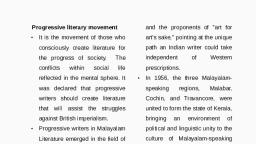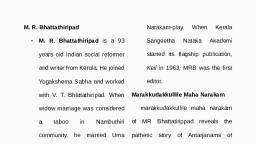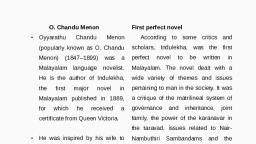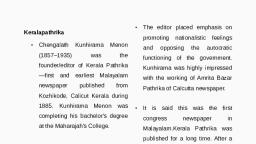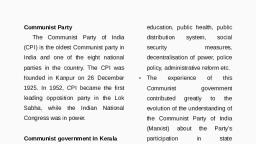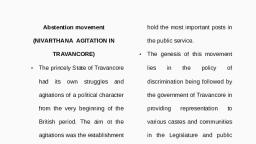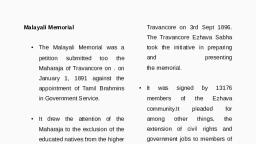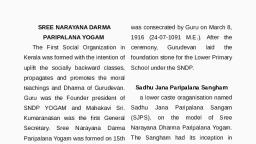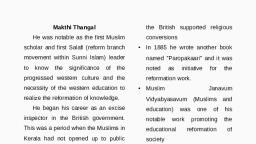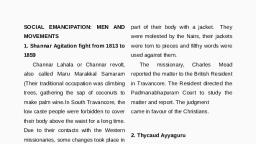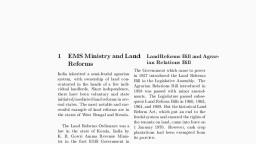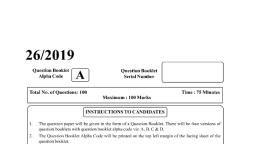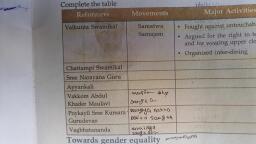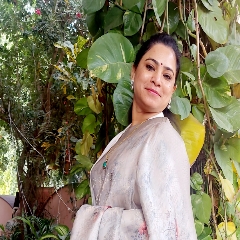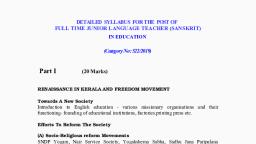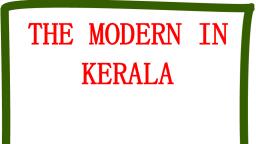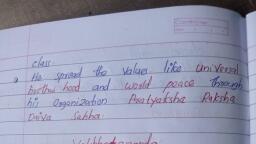Page 1 :
the caste-based restrictions of, , Sree Narayana Guru, , the time., , Sree Narayana Guru was born on, August 22, 1856 in Chempazhanthi, near Thiruvananthapuram. He was, named by his father as Narayanan; he, affectionately called him Nanu, a short, name for Narayanan. Despite his, marriage to a Kaliamma, daughter of a, , The Guru felt the necessity of, constructing a temple there for the, regular worship of Lord Shiva. The, Guru himself later installed a Shiva, linga (idol) in the temple. When asked, about his right to install an idol he, replied that the idol he had installed, , idols., , This, , symbolised his message that the, divine was within each individual., spiritual practices, , in a place to continue his spiritual, practices., Varkala,, , He, twenty, , chose, , Sivagiri, , at, , north, , of, , miles, , Thiruvananthapuram. He started a, Sanskrit school in Varkala and poor, boys and orphans were given free, education regardless of their caste, Thrissur,, , Against Caste Injustice:, gave the famous slogan, , “One Caste, One Religion, One, God for All” (Oru Jathi, Oru, Daivam,, , Manushyanu)., • In, , of, , Temples were built at different places –, , was not a Brahmin Shiva., , Oru, , instead, , a wanderer and decided to settle down, , Siva Lingam at Aruvippuram, , Matham,, , Kalavancode, he kept mirrors, , In 1904 the Guru gave up his life of, , traditional doctor of his village, , • He, , • In one temple he consecrated at, , 1888, he built a temple, , dedicated to Lord Shiva at, Aruvippuram which was against, , Kannur,, , Anchuthengu,, , Tellicherry, Calicut, and Mangalore. It, was in the year 1912 he built the, Sharada Devi Temple at Sivagiri., In 1913, he founded the Advaita, Ashram, , at, , Aluva., , This, , was, , an, , important event in his spiritual quest., This Ashram was dedicated to a great, principle – Om Sahodaryam Sarvatra, (all men are equal in the eyes of God).
Page 2 :
This became the motto of the new, , efforts, Dalits got the freedom to walk, , Ashram. Between 1918 and 1923 he, , on public roads, and Dalit children, , visited Sri Lanka many times. In 1921,, , were allowed to join schools., , a, , Universal, , The caste discrimination he faced as a, , Brotherhood was held at Aluva. Again, , child turned him into a leader of an, , in 1924, a conference of all religions, , anti-caste movement and who later, , was held there. The Guru stressed the, , fought for basic rights including access, , need for a Brahma Vidyalaya for a, , to public spaces and entry to schools., , comparative study of different religious, , Dalit, , Conference, , of, , faiths., , Ayyankali in 1893 rode an ox-cart, , Literary Works:, • He, , In, , MOVEMENT, , wrote, , challenging the 'ban' on untouchables, in, , from accessing public roads by caste-, , different languages. Few of them, , Hindus. This is celebrated as one of, , are: Advaitha Deepika, Asrama,, , the major achievements in the history, , Thevarappathinkangal, etc., , of Dalit movements in Kerala. He,, , 1928, , various, , the, , books, , Guru’s, , health, , conditions declined drastically and he, remained bedridden for some months., On 20 September, 1928 the Guru’s, soul left his body to unite with the, , later, also led a rally to assert the, rights, , of, , 'untouchables', , at, , Balaramapuram. An 'upper caste' mob, attacked them and a fight broke out., "The walk Ayyankali took came to be, known as 'walk for freedom', , Supreme soul., , Though Pulayars gained the right, Mahatma Ayyankali, , to access roads, temples and schools, , Ayyankali was born on August 28,, 1863,, , to, , Venganoor,, , Maala, which, , and, is, , Ayyan, , at, , now, , in, , Thiruvananthapuram, was a leader of, the lower castes and Dalits. With his, , were still inaccessible. Ayyankali had a, three-level solution for this., 1. First, to ask the government for, , help,
Page 3 :
2. second to fight with upper caste, , landlords, , reformer, , 3. third -- to start own schools. All, , three, , Vagbhatananda, , were, , enabled, , which, , in, , was, , a, , British, , social, India., , Vagbhatananda was born on 27th, April, 1885 in Patyam village that lies, , partially helped them to realise, , between, , their dream., , Thalassery, in Kannur District. In 1920,, , Kallumala agitation, , Kuthuparamba, , Vagbhatananda, , and, , founded, , the, , Kallumala agitationwas a social, , Atmavidya Sangham, whose principles, , revolution that took place in Kerala in, , he outlined in an Advaita treatise titled, , 1915. The upper class people in, , Atmavidya., , Kerala were not allowing the lower, , Unlike the Sree Narayana Dharma, , class people to wear the ornaments., , Paripalana (SNDP), which had been, , The people belonging to the Pulayar, , established by Narayana Guru and, , community protested against the upper, , was significant around the same time,, , class people for getting the right to, , the Atmavidya Sangham comprised, , wear the ornaments of their choice., , mostly professional and intellectual, , • He, , formed, , Sadhu, , Jana, , people and it had a more secular, , Paripalana Sangham (SJPS) to, , approach, , work for low castes., , instrumental, , • Efforts, , to, , “depressed, particularly, , organise, classes”, , reform., in, , the, , development, , and, , among, , of, , peasants, , It, , advancing, class, of, , was, the, , organisation, the, , region,, , untouchable, , spreading Marxist–Leninist ideas as a, , castes predated the nationalist, , counter to the overbearing feudal and, , movement, having begun in the, , religiously, , second half of the nineteenth, , Vagbhatananda himself criticised both, , century., , economic exploitation and the role of, , Vagbhatananda, , the, , to, , orthodox, , establishment., , foreign governments in supporting it.
Page 4 :
Vagbhatananda, died in October, 1939., , significance, , Sabhās., , The, , main, , agenda was to persuade people to, , Atmavidya Sangham declined after his, , fight against illiteracy and superstitions, , death, being superseded by other, , in Cochin State. He also formulated, , secular-oriented reform groups such, , the Pulaya Maha Sabhā for the uplift of, , as, , the Pulaya community., , Karshaka, , of, , called, , the, , the, , The, , groups, , Sangham, , that, , adopted its agenda. However, it was, , Famous, , still active in the 1980s., , Acharabhooshanam, , Pandit Karuppan, , Dhruvacharitham, , He was born to Paappu and, Kochupennu on May 24, 1885 in a, lower, , middle, , Cheranelloor,, Kandathiparambil, , class, near, Paapu, , family, , at, , Ernakulam., Karuppan, , book, , -, , Jathikummi, , ,, ,, , ,, , Chithralekha, , ,, , Kairaleekouthukam, Sahodaran Ayyappan, Ayyappan was born on August, 21,1889, , in, , Cherai,, , Vypeen, , in, , popularly known as Pandit Karuppan, , Ernakulam. Ayyappan was involved in, , Master or K.P. Karuppan was a, , public, , crusader against untouchability and, , vociferously voiced about the rights of, , other social evils prevalent during his, , the marginalised and questioned their, , time. For his relentless efforts in, , subjugation by the elite upper class., , uplifting the socially, economically and, , Sahodara Sangham, , educationally backward communities,, Karuppan Master earned the epithet, ‘Lincoln of Kerala’. He became the first, human rights activist from the Cochin, State., He started organizing the people of, Dheevara community into regional, , He, , discourses, , launched, , where, , the, , he, , Sahodara, , Sangham (Brotherhood Association), as a platform for young men interested, in initiating social change., Misra Bhojanam
Page 5 :
What, , can, , milestone, , in, , be, , considered, , Kerala, , a, , renaissance, , movement is the Misra Bhojanam, (inter-dining, , of, , upper, , castes, , in 1949, he became a Minister in the, Thirukochi State., He breathed his last on March 6,, , and, , 1968. His death marked the end of an, , outcastes) initiated by Ayyappan which, , era and the legacy left behind by this, , was a highly revolutionary activity that, , stalwart will remain etched in the, , was condemned by not just the upper-, , annals, , class elites but also certain reformists., , renaissance history., , This inter-dining earned him the name, of ‘Pulayan Ayyappan’, addressing him, as a member of Dalit community. But, all, , these, , taunts, , never, , dissuaded, , Ayyappan but further emboldened him, and only propelled him to launch more, revolutionary ideas., A journal titled ‘Sahodaran’ was, also, , started, , to, , help, , promote, , renaissance thoughts. He got the, prefix Sahodaran to his name after, this. He also coined a rejoinder Jati, Venda, Matam Venda, Deivam Venda, Manushyanu (No Caste, No Religion,, No God for Mankind), He was elected into the Kochi, Assembly in 1928. He was made a, Minister for Public Works in 1947. After, the unification of Travancore and Kochi, , of, , Kerala’s, , socio-cultural
